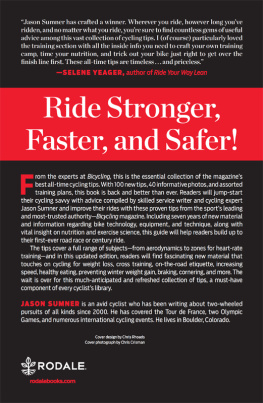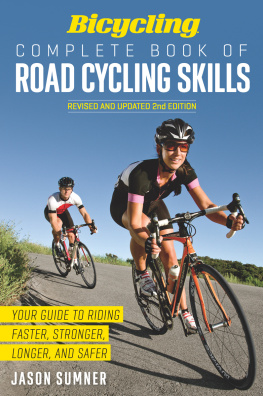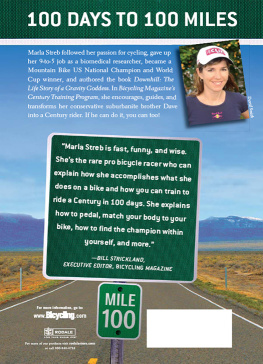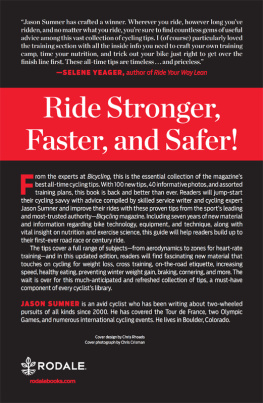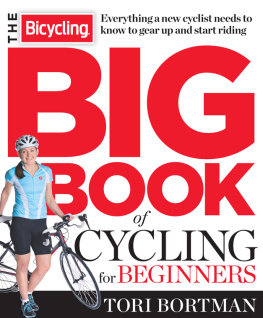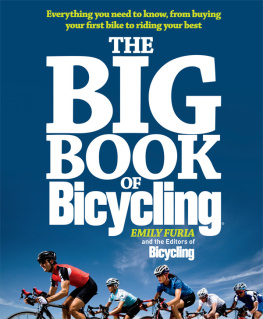The information in this book is meant to supplement, not replace, proper exercise training. All forms of exercise pose some inherent risks.
The editors and publisher advise readers to take full responsibility for their safety and know their limits. Before practicing the exercises in this book, be sure that your equipment is well-maintained, and do not take risks beyond your level of experience, aptitude, training, and fitness. The exercise and dietary programs in this book are not intended as a substitute for any exercise routine or dietary regimen that may have been prescribed by your doctor. As with all exercise and dietary programs, you should get your doctors approval before beginning.
Mention of specific companies, organizations, or authorities in this book does not imply endorsement by the author or publisher, nor does mention of specific companies, organizations, or authorities imply that they endorse this book, its author, or the publisher.
Internet addresses and telephone numbers given in this book were accurate at the time it went to press.
2013 by Rodale Inc.
All rights reserved. No part of this publication may be reproduced or transmitted in any form or by any means, electronic or mechanical, including photocopying, recording, or any other information storage and retrieval system, without the written permission of the publisher.
Bicycling magazine is a registered trademark of Rodale Inc.
Book design by Christopher Rhoads
All photographs by Mitch Mandel or Thomas McDonald with the exception of the following: Bruce Boyer (pages 32 and 40), Chris Hinkle (page 37);
Patrick Cavan Brown (page 50); ThinkStock (page 67); Erik Isakson (page 68);
Chris Hatounian (page 94); Jason Sumner (page 100);
Beth Bischoff (pages 120 and 132); Brand X Pictures (page 138)
Illustrations on page 6 by Charlie Layton; on pages 7 and 9 by Katy LeMay
Library of Congress Cataloging-in-Publication Data is on file with the publisher.
ISBN-13: 9781623360122 paperback
eISBN-13: 9781623360139

We inspire and enable people to improve their lives and the world around them.
rodalebooks.com
To all the talented editors and writers at Bicycling magazine and Bicycling.com who crafted so many of these great tips; to all the athletes, coaches, and nutritionists who graciously shared their professional expertise; and to all the worlds bike riders, be them Tour de France pros, weekend warriors, or coffee shop cruisers, who provided the inspiration for this book. Keep pedaling.
CONTENTS
INTRODUCTION
Want to become a better cyclist? Ride your bike. Its one of the great beauties of the sport. Every time you turn the pedals, summit a climb, dodge a pothole, roll over a rock, or bunny-hop a root, you become a better cyclist.
Of course we can all use a little extra help sometimes. And thats what this book is all about. On the following pages, youll find more than 1,100 ways to improve your cycling, tips and tricks gleaned from dozens of the worlds most skilled and knowledgeable cyclists.
So whether youre a leg-shaving road racer, a downhill-charging mountain biker, or just a weekend-pedal-to-the-coffee-shop beginner, there is a tip here for you. Read on, and then ride on.
CHAPTER
30 TIPS for Safety in Traffic
C ycling is one of the worlds safest and most enjoyable forms of transportation. Factor in the health benefits, and it might even come out on top. But there is no denying that 2 tons worth of sport-utility vehicle is something to be reckoned with. Use these techniques to ensure you dont find yourself SUV (Squashed Under Vehicle).
1] If drivers cant see you, they cant avoid you. That means wearing bright colors (think red, orange, yellow, and white) during daylight hours and equipping your bike with front and rear lights after dusk (and before dawn, if youre the ambitious sort).
2] Ride defensively, but not timidly. You are entitled to a place on the road, so use it. Be predictable, and go about your business with a self-assurance that shows you know what youre doing. This helps motorists anticipate your actions and feel comfortable sharing the road with you.
3] Always try to make eye contact with drivers. If theyre not looking directly at you, chances are they dont see you. By engaging with drivers visually and riding predictably, youll stay safer.
4] The number one priority for safety in traffic is visibility. And thats not just what you wear or making sure to have lights at night. On a road with no shoulder, ride in the right wheel track of motor vehicles to ensure you dont blend into the scenery along the edge of the road. This also gives you 3 to 4 feet of space from the edge of the pavement to allow for emergency maneuvers, such as dodging potholes or dealing with a wind gust.
5] Even the most conscientious cyclists sometimes break the rules of the road. When youre riding with other riders, lead by example, and if there are riders who have chronic issues with bad traffic habits, dont ride with them. That means staying off sidewalks and riding the right direction on one-way streets. Better yet, try to find roads that were designed with cyclists in mind. Google is beta testing cycling routes on its maps application.
6] Local cyclists are a great resource for finding the best routes in an unfamiliar city. Stop by a bike shop and ask for advice, and tap into that local knowledge. Many cities provide resources for locating roads that have bike lanes. Regardless of where you ride, you need to be confident and aware of your surroundings. Keep your eyes open so you can move into the lane gradually. And if you have to avoid obstacles, dont swerve. Thats more likely to put you in the path of a driver who thought there was enough room to get around you.
7] Recon your route ahead of time by car. Observe how wide the shoulder is, whether or not there is a bike lane, the quality of the pavement, and whether there are any other hazards that factor into safe cycling. If the roads are hazardous, seek out side roads or alternate routes.
8] Ride well into the lane when traffic is stop-and-go. A cyclist can usually move as fast asor faster thancars in heavy traffic, so dont hug the curb, where youre less visible and drivers will be tempted to squeeze by.
9] Stay far enough in the traffic lane to avoid being struck by doors suddenly opening on parked cars. Youll likely hear some honks from following motorists who dont understand why you wont pull to the right to let them pass, but hold your ground. A honk in your ear hurts less than a door in your face, and an opportunity to move right will come soon enough.
10] Dont gain ground at red lights by passing a line of cars on their right. Its illegal, and you can get doored from either side. It also irritates motorists because they have to pass you again after the light changes.
11] When you stop for a light, move to the center of your lane. This prevents drivers from edging forward, trapping you between them and the curb. When the light changes, accelerate to your cruising speed before moving right to allow them to pass.
[12] Hold a straight line past cars that are intermittently parallel-parked. In other words, dont weave in and out of empty spaces. Drivers might not be ready for you to suddenly reemerge in the traffic lane, and you never know whats hiding in those spaces.

